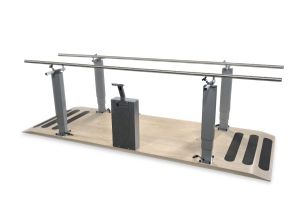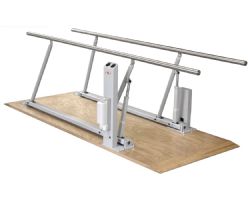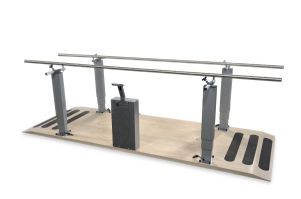 Written by Morgan Hopkins, DPT, CMTPT
Written by Morgan Hopkins, DPT, CMTPT
As a popular staple in physical therapy and rehabilitation, parallel bars provide two-sided support, helping people maintain their balance during ambulation and coordination exercises. Optimizing adjustability, access, and patient transfers, electric parallel bars make this therapy easier for both the patient and the therapist. Because age-related walking problems may be responsible for greater mortality and morbidity of older adults than acute illness and disease, it is vitally important to address these issues with electric parallel bars and other components of physical therapy. Read on to learn more about this beneficial upgrade for parallel bar therapy and how it can optimize patient outcomes.

Parallel bars are often used in physical therapy to help people recover from illnesses, injuries, and other debilitating conditions. They are an important tool in helping patients regain their strength, balance, range of motion, and ability to walk. Quickly gaining popularity with therapists and patients alike, electric parallel bars further optimize this therapy by making it easier to adjust the height and width of the bars to meet the changing needs of the patient along with meeting the needs of multiple users. Specially configured to enable easier and more accessible patient transfers to and from a wheelchair, electric bars generally support a wide range of rehab exercises, with customizable settings to meet different applications and patient needs.
 | Armedica Electric Power Bariatric Platform Parallel Bars View Product |
Recommended: Armedica Electric Power Bariatric Platform Parallel Bars
Electric bars provide ideal use for anyone who has a medical condition that makes walking difficult and hinders their balance, gait, and mobility. Providing stability and safety for people living with multiple sclerosis (MS), Parkinson’s disease, spinal cord injury (SCI), post-knee/hip surgery, severe muscle weakness, arthritis, post-stroke, and lower extremity fracture or amputation, electric parallel bars are also used for general conditioning exercises. Especially important for people who use wheelchairs for extended periods of time or those confined to bed, electric parallel bar therapy combines muscle-strengthening, range-of-motion, and ambulatory exercises to help counteract the negative health effects of sustained sitting or prolonged immobilization. In addition, the design of the electric bars optimizes access to ensure seamless transfers for patients who use wheelchairs and other mobility aids.
Known for its exclusive Return to Mobility suite of products to help patients get back on their feet, Hausmann Industries offers the best selection of electric parallel bars for physical therapy and rehabilitation. Both the Hausmann Power Height Parallel Bars and the Hausmann Patented Mobility Platform with Electric Height Bars highlight 4 direct-drive synchronized lifting columns to ensure stable, motorized height adjustability, along with manual width adjustability. With its unrivaled battery-powered design, the Electric Height and Width Bariatric Parallel Bars by Hausmann comes with two batteries so one can be charged while the other is in use. It conveniently powers both height and width adjustability. Available in a 10-foot length, all three models highlight tapered ends with an anti-slip tread for safe and easy wheelchair access. Bars extend past the platform when lowered, assisting wheelchair users to enter and exit the platform.
 | Electric Height and Width Bariatric Parallel Bars by Hausmann View Product |
Best: Electric Height and Width Bariatric Parallel Bars by Hausmann
Pairing the rehabilitative reliability and versatility of platform-mounted parallel bars with the technological advances common in today’s treatment tables, the electric bars from Armedica Industries are mounted on 3-section slimline lifting columns to deliver the utmost lateral stability - even in the highest bar position. The Armedica Electric Platform Mounted Parallel Bars and the Armedica Electric Power Bariatric Platform Parallel Bars both offer powered height adjustability combined with manual width adjustability. Available in a 10-foot length for the bariatric platform and in 7, 10, and 15-foot lengths for the regular platform, each end of these platforms is slightly sloped to enable easy roll-up access for wheelchair users, along with bars that extend past the columns. Memory buttons allow for convenient storage and recall of 4 different bar height settings, while the height range is also controllable with up and down arrows on the digital display.
 | Armedica Electric Platform Mounted Parallel Bars View Product |
Best: Armedica Electric Platform Mounted Parallel Bars
Frequently utilized for gait training, electric parallel bars provide ideal ambulation support and are often the first step in regaining the ability to walk. The powered height adjustability provides customizable balance and support for all of the movements involved with walking, including learning how to walk with a new prosthesis for people living with a lower extremity amputation.
Electric bars deliver improved facilitation for the recovery of various injuries, as their faster adjustability allows physical therapists to more quickly customize the height (and sometimes, the width) to meet the variable requirements of their patients. Useful for both lower and upper extremity injuries, electric parallel bars enable a wide range of rehab exercises and specific movements, ensuring the best therapy outcomes for patients.
Often used to help patients regain muscle and joint strength and mobility, electric parallel bar therapy can offer many benefits for people with debilitating conditions like osteoporosis, multiple sclerosis, and arthritis. Weakness, spasticity, pain, and loss of balance are just a few of the symptoms that can be improved through electric bar therapy. Specific strengthening and conditioning exercises become easier for patients to participate in when adjustments to meet their unique needs can be made with electric power rather than manual power.
Electric parallel bars provide exceptional support to help patients improve their balance and coordination skills. The solid, stable design of the bars combined with their fast height adjustability makes them an excellent tool for individual physical rehab and task-oriented procedures which require patients to repeat concise movements that work more than one joint and muscle. Because the abdomen plays such an important role in coordination and balance, therapists include abdominal strengthening exercises with electric bars to optimize recovery goals.
Electric parallel bars generally offer motorized height adjustability in addition to manual width adjustability. While some models of parallel bars do not adjust at all, electric bars typically offer a wide range of adjustability options to better suit multiple patients and their unique requirements.
The platform base of electric parallel bars tends to make them more stable and sturdy than regular parallel bars. This stability ensures safe use and a lowered risk of injury for both the patient and the practitioner.
Constructed with strong steel bars and sturdy, laminated platforms, most electric parallel bars are tough, durable, and easy to maintain. Built to withstand multiple clients in a physical therapy or physical rehab facility, electric bars are a smart investment for the long term.
Although electric parallel bars offer many advantages, there are a few disadvantages you should know before purchasing. Because they are heavy pieces of equipment, electric parallel bars are stationary and permanently positioned, so they are not a good option for portability. Their immovability also means that the patient will have to be moved, usually in a wheelchair, to the equipment. Even though they can be utilized at home, electric bars are more expensive than regular parallel bars, making them a better choice for physical therapy and physical rehab facilities.
Unlike the parallel bars used in gymnastics, electric parallel bars are utilized in physical therapy and physical rehabilitation applications. Specially designed to help patients optimize strength and regain walking, balance, and coordination skills, electric parallel bars maximize customizability to suit each unique patient requirement. Their powered adjustability makes it easier for rehab and therapy professionals to work with their patients, allowing much faster adjustments to facilitate a smooth therapy process.
Thanks for taking the time to learn more about electric parallel bars, and we invite you to read more informative articles on a wide variety of medical, rehab, and therapy topics at Caregiver University.

Morgan Hopkins is a licensed doctor of physical therapy and freelance medical writer. She practiced clinically in outpatient orthopedics for 8+ years specializing in intramuscular dry needling, dance medicine, and post-operative care. Morgan seeks to be a leader in the continued shift toward preventative healthcare, helping people optimize movement now so they can move for years to come. She is a firm believer in complementary therapies, holistic wellness, and functional fitness and is thrilled to be able to educate others through Rehabmart’s platform.